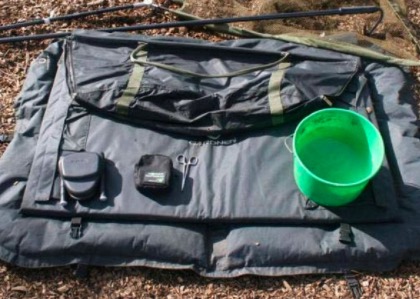
Carp Care!
The most important aspect of carp fishing, and possibly the one that gets overlooked the most, is bankside carp care.
People spend thousands of pounds on the best rods, sparkly reels and expensive alarms and then buy small unhooking mats and inappropriate landing nets. We need to ensure the fish we catch are returned back to the water in excellent condition, suffering the least amount of stress or damage so that these fish can be caught and admired again by other anglers.
Before you cast your rods out into the lake you should set up your carp care kit. Being prepared to handle and treat carp once caught means that you never leave a carp unattended on the bank.
Let’s start with the landing net;
A 42” or larger net with a deep and soft mesh is the least you should have. Make sure the net has a fine mesh as this will prevent the carp’s front pectoral fins from catching in the mesh whilst it is being landed. The landing net should also have removable arms which will make carrying the carp to the unhooking mat much easier.
Next the unhooking mat;
A large deeply padded unhooking mat is essential to protect the carp as they are naturally buoyant in water and do not feel their own weight. Once out of water they feel every ounce, so a soft unhooking mat helps protect their body from damage, as and when they begin to struggle. Place the mat on flat even ground staying away from gravel, brambles or thorns, which might hurt the carp if it manages to work its way off the mat.
A water bucket;
Position a large bucket of lake water and make sure this is as cool as possible. If you are fishing on a hot day, regularly check the temperature of the water in the container to ensure it is not getting too hot. The water is used to wet down the mat and to cool the carp once it is on the mat. The mat must always be well wetted down before you lay the carp on it, as it becomes very hot in the warm summer sun.
A dry unhooking mat will strip the mucus layer from the side of the carp and effectively leave the fish stripped of its protective layers allowing the carp to be more exposed to waterborne disease etc.
Carp care kit;
These are available from a number of companies, for example the Korda Carp care kits designed by Thinking Anglers. You can also get product such as Kryston Klinik carp care, which is also a good antiseptic/barrier. The Korda kit includes mouth and body liquid treatments with a few swabs included to assist in applying the treatments accurately onto the wounds.
A weigh sling;
Weigh slings are available in all shapes and sizes, so choose a sling that is soft and one that will support the fish well whilst it is being weighed. A sling with front and rear access zips also makes releasing the carp back into the water a lot easier.
And finally, your scales;
You need to have your scales next to the mat. If you have mechanical scales like Rubin’s or Avon’s, take a little time to wet the sling and zero your scales so they are ready for use when you need them. Finally make sure you have got your camera ready to go and within easy reach.
Landing your carp
If the margins are deep enough net the carp in the close margins, however, if you are fishing where they are very shallow it is best to try and move into a position where you can net the fish in deeper water. Alternatively you should be able to slip on your waders to net the fish in deeper water. Please note that wading is dangerous and shouldn’t be done unless this is a last resort.
Now you’re ready, here’s how to use the carp care equipment you have set up…
With the carp in the landing net, if you have someone around ask them to help by either holding the carp in the net, or, by wetting the unhooking mat and weigh sling for you. With the mat ready remove the arms from the landing net and roll up the net. Before lifting the carp from the water make sure its pectoral fins are tucked back along its body.
Lift the carp in the rolled up net and slowly walk over to the mat placing the carp carefully onto the wet mat.
Leave the net over the carp’s eyes and body and remove any sharp jewellery, watches, rings etc. that might damage the carp. Wet the carp and your hands to help cool them and start slowly unrolling the landing net. Slowly follow your line down making sure your rig is not trapped under the carp fins.
With the entire rig exposed, and clear of the carp, use the forceps to remove the hook from the carp’s mouth. If the fish flaps about – quickly cover its eyes and body with the landing net mesh until it lies still again.
Wet the fish again and now inspect the carp for any body or mouth damage using the carp care kit to treat any wounds found.
With the carp now checked over gently, remove the net and lift the carp into the wetted down weigh sling, making sure that the fins are all back against its body.
Zip up each end of the sling and attach it to the scales, gently lifting the carp just a few inches above the mat. Read the weight of the fish and lower back onto the wet mat very carefully.
And for the photography
If you have your photographer ready with the camera, gently lift the carp over the unhooking mat. Do not pick the carp up in a towel as this will strip the protective mucus from the sides of the carp.
When picking up the fish, place one hand under the front pectoral fins and the other around the anal fin and hold the carp vertically in your hands about 6” to 10” inches away from your body. Only lift the carp a short distance off the mat as we do not want the carp to fall from a dangerous height. As you are holding the carp, if it starts to flip, let it fall back into you’re forearms and gently lower the fish down to the mat.
Once the photos are taken place the carp back into the weigh sling making sure the fish is upright and its fins are back against its body.
Returning the carp
Now return the carp to a deep marginal spot to release it back into its watery home.
At the bankside spot, lower the sling into the water and slowly unzip the front of the sling allowing water to flood over the fish.
Lift the back end of the sling and gently allow the carp to slide back off into the water. Make sure the carp is OK and watch it swim off. If the fish shows any sign of distress do not leave the fish on its own, stay with it until it shows it has enough strength to swim away. Never keep fish out of the water for any longer than is absolutely necessary.
And a final word on why carp care is so important…
Treat the fish you catch with respect and care for them when they are on the bank. The fish you have caught may only be a 10lb fish but with the right conditions it may well grow to be the next record fish.
The pressure on carp has never been so immense and there is no sign of this letting up. The carp we are catching today are the future and they will be the specimens that anglers will be hoping to catch tomorrow. If we do not care for them then now then there will no future sport for anglers to enjoy.

Credit: anglinglines.com

